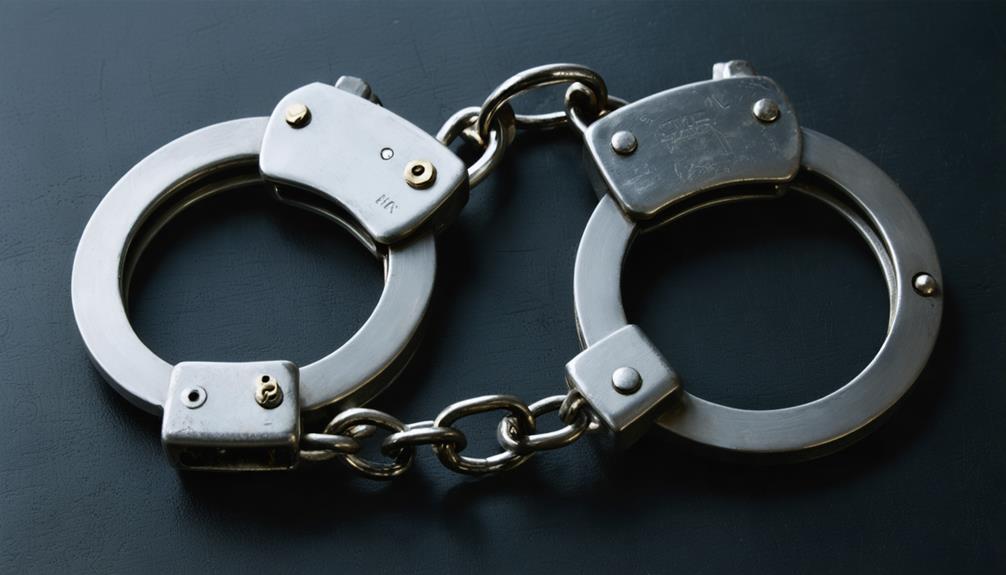
Brainstorm Security Shop

For Orders Over $199

On Any Of Our Products

Details On Refund Page
When you think about handcuffs, the double lock feature probably doesn’t come to mind immediately, but it’s vital for ensuring safety during detainment. By engaging this handcuff mechanism, you can prevent the cuffs from tightening uncontrollably, which not only protects the individual in custody but also enhances your control in tense situations. However, there’s more to this feature than just its basic function. What misconceptions might you have about its effectiveness, and how does it truly impact law enforcement practices? Shop at brainstormsecurityshop.com for low prices!
When you consider the safety and security of individuals in custody, the importance of double locking handcuffs becomes clear. Double locking isn’t just an extra step; it’s a vital part of the proper technique used by law enforcement. When handcuffs are double-locked, they prevent any unintended tightening that could cause injury or discomfort to the person in custody.
You need to recognize that adhering to training requirements is essential for ensuring effective use of handcuffs. Officers must practice double locking as part of their training to develop the skills necessary for safe and responsible restraint. This technique minimizes the risk of escape and helps maintain control of the situation, which is crucial in high-stress environments.
Incorporating double locks into your routine not only protects the individual but also enhances the safety of officers involved. By prioritizing this practice, you foster a culture of professionalism and care.
Ultimately, double locking handcuffs is a fundamental practice that embodies both accountability and respect in law enforcement, ensuring that the rights and safety of individuals in custody are upheld at all times.
The mechanism of a double lock in handcuffs is designed to enhance safety and prevent accidental tightening. When you engage the double lock mechanism, it essentially locks the ratchet in place, ensuring that the cuffs won’t tighten further once they’re secured around a wrist. This feature is crucial because it prevents any unintentional constriction that could cause discomfort or injury.
To activate the double lock, you typically press a button or slide a lever on the handcuff. This action engages the security features that maintain the current size of the cuffs. You’ll notice a distinct click, indicating that the double lock is engaged. Once activated, the handcuffs remain at the same level of tightness, providing maximum security without compromising safety.
This double lock mechanism serves as a vital layer of protection for both the person in custody and the officer. It helps to ensure that the handcuffs won’t accidentally tighten during movement, reducing the risk of injury. Understanding how this mechanism works can enhance your appreciation for the thoughtful design behind handcuffs, ensuring that they serve their purpose effectively and safely.
Understanding the double lock mechanism not only highlights its safety features but also showcases its benefits for law enforcement. When you use handcuffs with a double lock, you gain enhanced security for both yourself and the individuals you’re apprehending. This mechanism ensures that once the cuffs are secured, they can’t be easily manipulated or tightened further, reducing the risk of injury or escape.
With improved control over the situation, you can focus on managing the encounter rather than worrying about the integrity of your restraints. This added layer of security allows you to maintain authority and confidence, knowing that the handcuffs are doing their job effectively.
Additionally, the double lock feature helps prevent the subject from slipping out of the cuffs, which can be a significant concern during transport or when dealing with uncooperative individuals. With these handcuffs, you can better ensure that suspects remain safely restrained until you can process them further.
Ultimately, incorporating double lock handcuffs into your toolkit gives you peace of mind and enhances your ability to perform your duties efficiently and safely.
Many people often overlook the importance of the double lock feature in handcuffs, leading to several misconceptions about its function and effectiveness. One common myth is that the double lock is merely an extra step in the cuffing process. In reality, it serves a critical purpose in preventing accidental tightening, which could lead to discomfort or injury. Without this feature, you might face legal ramifications if a suspect claims excessive force was used during an arrest.
Another misconception is that the double lock is unnecessary if you’re using proper technique. While good technique is essential, relying solely on it can be risky. Handcuffs can shift during transport or struggle, making the double lock crucial for maintaining control and safety.
Additionally, some believe that all handcuffs have a double lock feature, but that’s not always true. It’s essential to know the specific handcuffs you’re using, as not all models are designed with this safety mechanism. Understanding these misconceptions helps you appreciate the double lock’s role in ensuring a secure and compliant arrest, ultimately leading to safer interactions for everyone involved.
When selecting handcuffs, it’s crucial to consider your specific needs and circumstances. Think about who’ll be using them and in what situations. Proper sizing is essential; you want to ensure the handcuffs fit securely without being overly tight. This not only enhances safety but also prevents discomfort for the person being restrained.
Next, pay attention to material quality. Handcuffs made from durable materials like stainless steel or high-grade aluminum offer better strength and longevity. If you’re looking for lightweight options, consider composite materials, but ensure they can withstand the necessary pressure.
Also, check the locking mechanisms. Double lock features are particularly important for preventing accidental release, which adds an extra layer of security.
Before making your final decision, it’s wise to read reviews and perhaps even test different models if possible. You want a set that’s reliable, easy to use, and meets legal requirements in your area. Ultimately, choosing the right handcuffs means prioritizing safety and functionality tailored to your specific needs.
Not all handcuff models have double lock features. While double lock benefits include increased security, some limitations exist. You should consider double lock training techniques to ensure proper usage and enhance your overall handling skills.
To maintain your double lock mechanism, regularly clean it using proper techniques, apply lubrication maintenance, and check for common issues. If problems arise, use troubleshooting tips to ensure everything functions smoothly and reliably.
When comparing costs, double lock handcuffs typically are more expensive than standard ones. However, their added benefits in effectiveness and usability make them a worthwhile investment for enhanced security and control in various situations.
When considering materials for double lock handcuffs, you’ll find steel for durability, titanium for lightweight options, and carbon fiber or aluminum for strength. Each material offers unique benefits tailored to different user needs and preferences.
Yes, double lock handcuffs can be used on individuals with small wrists, but you should always consider child safety and special populations. Proper adjustment ensures comfort and effectiveness, preventing potential injury or escape.
